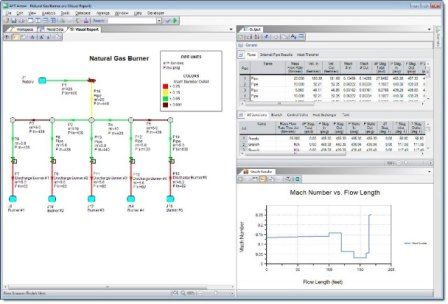AFT Blog
Why Gases Are More Complicated Than Liquids: And How the New AFT Arrow 5 Can Help
Several generations of engineers ago engineers realized that performing calculations on gas flow is a lot more difficult than for liquids. As a result, the bulk of what is gas flow engineering history has revolved around how to treat gases as liquids. Another large portion of history is how to simplify gas flow equations down to simple isothermal relationships. In other words, the majority of gas flow engineering historically is about how to take short cuts with gas flow calculations.
Today it is no longer necessary to take short cuts. But all too often we see engineers doing just that. AFT Arrow is AFT's gas flow simulation software and it will be celebrating its 20th anniversary next year. Just last week I had a conversation with an AFT Arrow user from a well known engineering firm who was required by a client to use gas modeling software from one of our competitors on a project.
The system was a large steam distribution system and the competitor's software was unable to predict what happened under certain conditions which appear to have involved sonically choked flow. The engineer called us to ask our opinion on what was happening and how to form a response to their client. We sent some example models and explained what we believed the issue was and why it is so hard for software based on short cuts to solve such situations.
Why Are Gases More Complicated?
So why is it so hard to calculate gas flow? And what are the pitfalls of using short cut methods and much of the commercial software out there which is based on the short cuts?
Back in 2000 I wrote a technical paper for Chemical Engineering magazine that answered many of these questions - in some cases for the first time printed in the open literature. Here is a link to Gas Flow Calculations: Don't Choke.
- Gases are compressible - this is of course obvious to gas system engineers. The compressibility of gases means that fairly simple relationships for liquids where the density is treated as a constant get more complicated very quickly.
- Velocity changes in constant diameter pipes - this is a result of the changing density as is summarized as Equation 2 in the Chemical Engineering paper linked above. To make things even more complicated, the velocity is non-linear.
- Density is strongly linked to temperature - in liquids the link between density and temperature exists, but it is typically weak. In gases the link is strong and must be accounted for. The equation of state relates how the gas density, temperature and pressure are coupled. The equation of state must be solved simultaneously with the equations of flow in order to properly account for the density/temperature coupling.
- Sonic flow limitations - while liquids have a speed of sound like gases, it is rarely if ever an issue with liquid flow. With gases the speed of sound is frequently an issue. When the gas velocity reaches the speed of sound then the flow is said to choke. This is sometimes called critical flow. The Mach number of the gas goes to 1. And the flow has reached the maximum possible for the given supply conditions. Sonically choked flow is a defining feature of many gas system applications with gas relief valve systems being a good example. The Chemical Engineering paper linked above discussed this and more of the challenges with accurately calculating choked flow.
- Pipe networks - matching up various single pipe gas calculations when there is a network of parallel and/or branching pipes quickly becomes overwhelming for the engineer. Not only must mass be balanced, but also energy must be balanced. This can become quite complicated.
How New AFT Arrow 5 Can Help
A completely new version AFT Arrow will be released in August - AFT Arrow 5. Similar to the most recent versions of AFT Fathom and AFT Impulse, AFT Arrow will include a host of new interface and technical features with a more modern look and feel.

From the beginning AFT Arrow was a leader. AFT Arrow, first released in 1995, was the first graphical simulation tool for Microsoft Windows that modeled compressible flow in pipe systems. Moreover, AFT Arrow does not take short cuts. It solves the fundamental mass, momentum and energy equations while including real gas equations of state, Mach number and sonic choking, as well as simulating heat transfer and performing a global system mass and energy balance.
The solution algorithms in AFT Arrow were developed in the original version 1 and then refined in version 2 in 1999 to more robustly solve systems with sonic choking in parallel flow paths. Since that time the solution algorithms have proven to be accurate and robust. For the last 15 years AFT Arrow has been helping engineers simulate compressible flow in a wide range of gas systems.
AFT Arrow 5's updated look and feel and new features together with the proven solution technology will help today's engineers design safer, more efficient and more reliable pipe systems than ever before.



Comments 1
Flow of Liquid can be cotroled if it has more resistance but the air have less resistance but more diffcult to control the FLOW